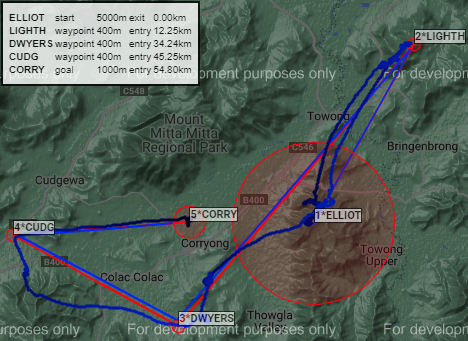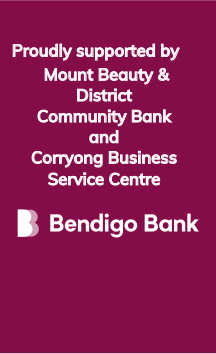Competition Scoring for new pilots
The purpose of a the scoring system in a hang gliding competition is to rank pilots in order of flying proficiency.
Competitive hang gliding sometimes involves individual chance so competitions take place over several days to reward consistent flying proficiency.
Hang gliding tasks are set daily by a task committee of pilots based on prevailing weather and expected flying conditions. The task will involve flying a set course around a series of waypoints finishing at the goal.
A typical competition day might involve:
- Task briefing on the hill around noon where you will be given the day's task information.: Turn direction inside the start circle; launch window open time; start gate times and task distance; todays turnpoints and radius of the task start, turnpoints and goal. This is when you will program the task into your navigation instrument. It's important to get this right, a good check is to make sure your instrument shows the same total task distance as the task board. Look at the task on a map. This is to help you recognise the waypoints from the air, and also to plan how you can use the terrain to your advantage. It can also be helpful to write the task waypoints and a "mud map" on some tape and stick it to your basebar.
- Once the "Launch Window" is opened competitiors will be allowed to launch. Free flyers may have been allowed to launch beforehand so that waiting competitiors will be encouraged by pilots soaring overhead. Most hill start competitions will employ a launch order based on pilot ranking. This will be outlined at the pilot briefing. Learn who the pilots are in the few places in front of you and be ready to get in the queue. When your time at launch arrives, wait until conditions are safe then 'fly like a bird'.
- Climbing to cloudbase before you start. Our wings are powered by gravity so altitude is fuel in the tank. You want to start the race with a full tank. The time you spend climbing before crossing the start circle will shorten your elapsed-time on course.
- Starting the task may involve either exiting or entering a virtual circle. With an exit start you exit a virtual start circle centred around the start waypoint. An exit start circle is usually around 5km radius. Some competition starts may use an entry start which involve entering a (usually large) virtual circle centred around the first turnpoint. The advantage of an entry start is that all of the pilots don't have to be contained at the same place inside the start waiting for the start gate. They can find a thermail and stay high anywhere near the edge of the entry circle (maybe upwind of the first turnpoint) while they wait to start . In the scoring jargon this is the Start of the Speed Section (SSS). You can start multiple times, it's the last start that counts (subject to start gates).
- A competition may employ 'start gates' to prevent a pilot starting with a gaggle then going back for a re-start and catching-up with the gaggle again. This pilot can effectively beat his/her rivals at the start of the race instead of the finish. All they have to do is keep up with the gaggle and make goal to have a faster elapsed time. Start gates are pre-defined timed intervals when starts can occur (for example an task may have 4 start gates at 30 minute intervals). When you leave the start circle your elapsed time starts at the preceeding start gate interval. The effect this has is pilots will start together in groups as soon as possible after a start gate interval. The intention of this is to remove any advantage of re-starting and catching-up, and stops the entire gaggle re-starting after one pilot does it. There are penalties for "jumping the gun" (starting before the first start gate), but these are only applied if you make the goal.
- Flying the course may require flying through one or many turnpoints. These are usually 400m radius virtual circles centred around the course waypoints but can be much larger. You must record track waypoints inside the turnpoint circle. Flight recording instrument don't record your location continiously, they record at set intervals ie: every 5,10 or 20 seconds. It is possible to quicly fly in and then out of a turnpoint circle without recording trackpoints. It is prudent to manually save a trackpoint inside eack turnpoint if your flight instrument doesn't do this automatically.
- Finishing involves entering the virtual circle (usually 1km radius) or sometimes crossing a line, the End of the Speed Section (ESS). At most competitions the ESS and goal use the same waypoint. The pilots elapsed time is taken from the applicable start time to the finishing time (SSS to ESS). Once a pilot has made it to goal they may continue flying if they wish. You do not have to land at goal but there is usually beer there!
- After you have landed and finished flying for the day you need to make your track log available to the scorer. Do this at your earliest opportunity ie: email it to the scorer or upload to the scoring website before packing up your glider. This not only allows the scorer be finished earlier but also lets the competition organisers know that you have landed and are safe.

The scoring system rewards pilots who complete a set flying task/course in the shortest elapsed time. Additional points can be gained by completing the task earlier than other pilots (who may be following you).
In order to be scored a pilot must record a GPS track log of their flight and submit this to the scorer or scoring website in .igc format. This file type (.igc = International Gliding Commission) is a secure format that is supposedly invalid if the file is modified after being created and signed by the originating instrument.
Most hang gliding competitions are scored using the GAP scoring system, so named after the trio of pilots that created it Gerolf, Angelo & Paul.
The GAP scoring system has several iterations with minor variations, competitiors should be aware of which version is being used at any given competition.
To score a task, all competing pilot tracklogs are required. You should always submit your daily tracklog ASAP after landing, even if you didn't fly very far.
Task validity (a number between 0 and 1) is calculated. This evaluates how suitable the task was for the competing pilots. It incorporates how many of the pilots launched, how many made goal and how fast goal was achieved. This means if you chose not to fly or are absent (or injured) on any particular day the scorer needs to know.
Each day winner can receive up to 1000 points (1000 x task validity).
Scores are composed of Distance points + Speed points (elapsed time) + Departure points + Arrival points + Leading-out points. Departure, arrival & leading-out points are not always used. They are to reward pilots who are either more skilled (or less risk averse) and start earlier, arrive earlier or lead-out flying without the assistance of other pilots marking thermals ahead on course. This is because is easier and involves less risk to follow others and benefit from their flying decisions (colloquially known as pimping). You should be informed at the initial pilot briefing or daily briefing which scoring features will be used.
Pilots that do not make it to goal will only receive distance points. Don't risk landing short of goal by trying to go too fast.
The best advice for pilots new to competition is launch early (as soon as it is soarable) and fly conservatively (don't race to the ground). The longer you can stay in the air the better your chances of getting around the course and to the goal. By going early you will have more pilots passing by you in the air and marking thermals ahead. If you do happen to bomb-out (landing inside the bomb-out circle which is usually the same as the start circle) you will still have time to re-fly. You do not have to fly the course quickly, just getting to goal consistently will see you do well in the scoring.
Understanding your flight instrument is very important. Learn how to program a task, fly/walk/ride that task and then retrieve the .igc file for scoring. It can be very dissappointing to find that you have missed goal points because you didn't mark the a turnpoint due to an error in programming or no trackpoints in sector. Before launching double check that you have the task programmed correctly
For further reading about competition scoring see below.
![]() SAFA Competition Manual 2019_v19.0
SAFA Competition Manual 2019_v19.0

